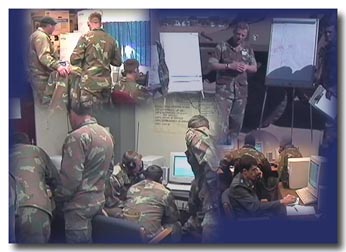Projects
A summary of key projects include the following:
- Development of a comprehensive
database for current and future students in the field of
Human Factors in Virtual Reality Systems.
- Investigation into the usability and design
issues involved in Integrated Virtual
Battlefields.
- Investigation into the prevalence of
leadership styles in Virtual Organisations.
- Investigation into improved
interpretation, retention and application of Geographic
Information. A specific application is map reading in the
SANDF.
- Investigation into issues related to
Transfer of Training where use is made of computer
visualization and Virtual Reality rendering techniques.
- Investigation into alternative
rendering techniques applied to Geographic Information
for improved interpretation, retention and application of
Geographic Information. This project is conducted in
association with the Department of Geography and
Environmental Studies.
- An investigation into the Human
Factors issues in Virtual Libraries and Interactive
Learning and Research Environments.
Detailed discriptions of projects
Julia Muetudhana: Managerial leadership in virtual and mechanistic organizations
Julia is conducting an exploratory study on organisations and different leadership styles that prevail in these organisations.
She has found that there is a great number of descriptive studies, but limited empirical research on "organisational structures".
Her research project distinguishes between the structures of mechanistic and virtual organisations and
between transactional and transformational leadership. Her research is based on the assumptions that transactional
leadership will be more prevalent in mechanistic systems while transformational leadership will be more prevalent
in virtual organisations. These assumption are to be tested by means of a questionnaire which she has developed
to measure the mechanistic and virtual structures; transactional and transformational leadership styles prevalent
in these organisations.
Madia de Jager: Usability of digital battlefields

The rapid and ever increasing advances in the field of digital technology
and the application thereof in information technology, culminated in the creation
of realistic synthetic environments, known as Virtual Reality. Virtual Reality's
potential as a medium for improvements in communication between humans and computers
is receiving increased attention. Madia's research provides an overview of the importance
of the inclusion of usability evaluation and engineering, highlighting the benefits
associated with a user-centred human-computer design approach. In her study she reviews
the characteristics of usability, specifically applicable to digital battlefields in
the military. Issues addressed in her research include general user characteristics, types
of tasks and characteristics thereof, applicable to synthetic environments of a military nature.
Within Madia's study the concept of digital (virtual) battlefields is used, and refers
to the military use of computer-generated imaging and electronically created environments,
intended for combat readiness preparation (for example as a war gaming tool). Usability is
aimed at optimised system effectiveness and refers to the degree to which a system is easy
to use, easy to learn, and optimised from the end-user's perspective. The goal of usability
engineering and evaluation is to ensure that the system takes account of human capabilities,
skills, limitations and needs. The benefits of usability engineering and evaluation include
ease of learning, ease of use, technology acceptance, enhanced productivity, fewer operating
errors and end-user satisfaction to facilitate overall system acceptance.
Elisca Philander: Competency investigation and transfer of training
Elisca's research is focused on a comprehensive Training Needs Analysis, based on a
detailed task analysis, aimed at determining the current competency level of interpretation
of Geographic Information through map reading skills in a military context. The research is
also focused on ascertaining whether the current level of map reading is adequate in terms
of the tasks expected. The sample consists of approximately 800 participants, from different
units in the SANDF. Elisca also completed an article for publication on the potential use of
virtual reality training systems to improve the transfer of training to the real world
environment.